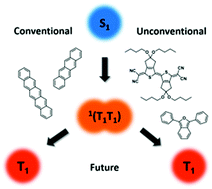Unconventional singlet fission materials
Abstract
Singlet fission (SF) is a photophysical downconversion pathway, in which a singlet excitation transforms into two triplet excited states. As such, it constitutes an exciton multiplication generation process, which is currently at the focal point for future integration into solar energy conversion devices. Beyond this, various other exciting applications were proposed, including quantum cryptography or organic light emitting diodes. Also, the mechanistic understanding evolved rapidly during the last year. Unfortunately, the number of suitable SF-chromophores is still limited. This is per se problematic, considering the wide range of envisaged applicability. With that in mind, we emphasize uncommon SF-scaffolds and outline requirements as well as strategies to expand the chromophore pool of SF-materials.



 Please wait while we load your content...
Please wait while we load your content...